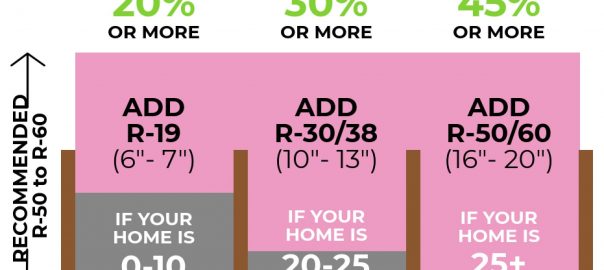How important is Insulation R-Value?

Resistance Value or R-value for short is a term that is always thrown in where insulation is mentioned. R-value refers to how well that material slows down heat transfer per inch of thickness. Generally speaking, higher R-value is better. The Ontario Building Code recommends R-value of between 50 and 60 for attic insulation.
Why R-value is Important
The main job of insulation is to slow down heat flow which becomes especially important during summer and winter months when the HVAC system has to work harder to maintain ambient temperature. The insulation keeps warm air indoors during winter and blocks hot air from outside during summer.
If left to its own devices, heat naturally transfers from the warmer area to the cooler area. Over time there is minimal difference in air temperature. So in the summer, for example, the warmer air outside is naturally drawn indoors while the opposite is true during winter.
Typical construction material has low R-value. For every ½ inch of thickness, drywall has R-0.45 and exterior plywood R-0.63. A concrete wall 8 inches thick has roughly R-1.9 to R-2.5.
You can add R-0.5 to a concrete wall by doubling its thickness.
The necessity of insulation is therefore clear. Construction materials are poor at regulating indoor vs. outdoor temperature and more so during extreme weather.
The main factors that determine the R-value of insulation include the type of material, its density and its thickness.
Calculating Insulation R-Value
To calculate R-value, simply multiply the R-value of the material by its thickness. For example, a one-inch thick piece of solid wood has an R-value of R-1. Three inches of the same solid wood is now R-3.
R-value per inch of thickness varies depending on the specific material the insulation is made out of. Below is a general guide to R-values for different types of attic insulation courtesy of the Department of Energy.
| Material | R-value/in |
| Fibreglass blown in | 2.2-4.3 |
| Fibreglass batts | 3.1-3.4 |
| Cellulose blown in | 3.2-3.7 |
| Mineral wool batts | 3.1-3.4 |
| Mineral wool blown in | 3.1-4.0 |
Apart from the general guideline provided by the Ontario building code, the optimum R-value for your attic depends on your climate and the type of heating and cooling system you have in your home. Have a professional inspect the attic and recommend the best type of material, installation type and R-value if you intend on upgrading your attic insulation.
Adding New Insulation over Old Insulation
It is often possible to install new insulation over existing one to bring it up to date or to the recommended R-value. There are situations where you should remove the old insulation before installing new.
If the old insulation is wet, you definitely need to remove it before installing the new one. Mould is a major concern and will spread to the new insulation. Moisture affects the insulation’s capacity to perform properly so the old insulation is most likely useless if wet or moist. Adding the new insulation over the ‘dead’ one still won’t bring you up to code.
Do not install insulation with a vapour barrier over existing insulation. The vapour barrier in between layers of insulation traps moisture and will soon destroy the old and new insulation.
Definitely get your insulation tested for asbestos if you have vermiculite insulation. Asbestos is toxic and has been linked to various cancers. Do not attempt to remove the insulation yourself and stay out of the attic until professionals arrive. Disturbing the insulation is what makes it dangerous by making the toxic fibres airborne where they can be inhaled or ingested.
Hire a Professional to Install New Insulation
Homeowners with DIY skills and experience often like to remove/install their own insulation but it doesn’t make it a good idea.
Blown in fibreglass can cause respiratory issues, skin irritation and eye irritation if installed without a proper or good quality protective gear. Air leaks in the attic are difficult to spot and can seriously limit the R-value of your insulation regardless of the number printed on the packaging.
Hire an attic insulation removal company in Toronto to assess the condition of your existing insulation before giving a professional opinion on the way forward. The technicians will also clean and organize the attic beside professionally installing new insulation and safely removing old and/or toxic insulation. Make sure you get a warranty for the service.